Wearable EEG Sensor Analysis for Cognitive Profiling in Educational Contexts
Abstract
1. Introduction
1.1. Conceptual Understanding (CU) and Procedural Knowledge (PK) of Fractions
1.2. Neurocognitive Basis of Fraction Processing
1.3. Theoretical Framework and Research Questions
- To examine sixth-grade students’ levels of conceptual understanding and PK of fractions, as well as their performance on applied tasks such as Fraction Lab and the Diamond Paper, in order to build a comprehensive picture of each learner’s mathematical profile.
- To classify students into distinct cognitive and neurophysiological profiles using data from the RODI test, EEG recordings, and performance assessments, thereby enabling the identification of learning patterns and needs.
- To explore how these individualized profiles can inform the development of personalized learning pathways, with the goal of tailoring educational interventions to optimize engagement, comprehension, and long-term retention in mathematics.
2. Materials and Methods
2.1. Participants
2.2. Research Tools
- Assessment of Students’ Cognitive Abilities: Students’ cognitive abilities were evaluated using the “RODI TEST”, a tool approved by the Ethics and Deontology Committee of the Ionian University under protocol number 3600/13-09-2022. Demographic information was also collected as part of this assessment.
- Evaluation of Conceptual (CU) and Procedural Knowledge of Fractions (PK): The evaluation of students’ CU and PK regarding fractions involved the use of multiple research instruments:
- A validated 25-item tool was used to assess sixth-grade students’ procedural and conceptual understanding of fractions [24]. It includes ten items targeting procedural skills and fifteen multiple-choice items designed to evaluate conceptual understanding while minimizing reliance on procedures. The tool demonstrates strong psychometric properties (CVI = 1; Cronbach’s = 0.921 for procedural, 0.731 for conceptual tasks) and was administered via Google Forms. Results were analyzed separately for each section, offering a reliable measure of students’ fractional competence (Link to Test).
- Fraction Lab, developed by Mavrikis et al. at University College London (UCL), is a research-validated digital platform designed to enhance both conceptual and procedural understanding of fractions [64,65]. It combines exploratory activities and structured exercises, allowing students to visualize fractions through number lines, area models, and dynamic partitioning. In this study, Fraction Lab assessed fraction equivalence and ordering, with all interactions securely recorded (Link to Test).
- Diamond Paper, a versatile tool inspired by Boaler’s framework [66,67], and developed following recommendations by Cathy Williams, enables students to interpret fractional relationships using four distinct approaches. Adapted from the widely recognized Diamond Template, it prompts students to create a narrative, draw a sketch, represent fractions with objects (all targeting conceptual understanding), and perform a calculation (PK). Each student completed an A4 sheet folded into a diamond shape, centered on a given fraction relationship, with responses later scanned, graded, and securely stored.
2.3. Collection and Pre-Processing of EEG Data
3. Results
4. Discussion
5. Conclusions
Author Contributions
Funding
Institutional Review Board Statement
Informed Consent Statement
Data Availability Statement
Conflicts of Interest
References
- Braithwaite, D.W.; McMullen, J.; Hurst, M.A. Cross-notation knowledge of fractions and decimals. J. Exp. Child Psychol. 2022, 213, 105210. [Google Scholar] [CrossRef]
- Booth, J.L.; Newton, K.J.; Pendergast, L.L.; Barbieri, C. Opening the Door to Algebra: The Role of Fraction Knowledge in Algebra Learning; International Society of the Learning Sciences, Inc. [ISLS]: Bloomington, IN, USA, 2018. [Google Scholar]
- Siegler, R.S.; Lortie-Forgues, H. Hard lessons: Why rational number arithmetic is so difficult for so many people. Curr. Dir. Psychol. Sci. 2017, 26, 346–351. [Google Scholar] [CrossRef]
- Nunes, T.; Bryant, P.; Pretzlik, U.; Bell, D.; Evans, D.; Wade, J. Children’s understanding of fractions. Contrapontos 2008, 8, 509–517. [Google Scholar]
- Stafylidou, S.; Vosniadou, S. The development of students’ understanding of the numerical value of fractions. Learn. Instr. 2004, 14, 503–518. [Google Scholar] [CrossRef]
- Hoffer, T.B.; Venkataraman, L.; Hedberg, E.C.; Shagle, S. Final Report on the National Survey of Algebra Teachers for the National Math Panel; NORC at the University of Chicago: Chicago, IL, USA, 2007. [Google Scholar]
- Barbieri, C.A.; Rodrigues, J.; Dyson, N.; Jordan, N.C. Improving fraction understanding in sixth graders with mathematics difficulties: Effects of a number line approach combined with cognitive learning strategies. J. Educ. Psychol. 2020, 112, 628. [Google Scholar] [CrossRef]
- González-Forte, J.M.; Fernández-Verdú, C.; Van Dooren, W. Is there a gap or congruency effect? A cross-sectional study in students’ fraction comparison. Stud. Psychol. 2020, 62, 109–122. [Google Scholar] [CrossRef]
- Reinhold, F.; Hoch, S.; Werner, B.; Richter-Gebert, J.; Reiss, K. Learning fractions with and without educational technology: What matters for high-achieving and low-achieving students? Learn. Instr. 2020, 65, 101264. [Google Scholar] [CrossRef]
- Gómez, D.M.; Dartnell, P. Middle schoolers’ biases and strategies in a fraction comparison task. Int. J. Sci. Math. Educ. 2019, 17, 1233–1250. [Google Scholar] [CrossRef]
- Ni, Y.; Zhou, Y.D. Teaching and learning fraction and rational numbers: The origins and implications of whole number bias. Educ. Psychol. 2005, 40, 27–52. [Google Scholar] [CrossRef]
- Ismail, S.A.S.; Maat, S.M.; Khalid, F. 35 years of fraction learning: Integrating systematic review and bibliometric analysis on a global scale. Eurasia J. Math. Sci. Technol. Educ. 2024, 20, em2543. [Google Scholar] [CrossRef]
- DeWolf, M.; Vosniadou, S. The representation of fraction magnitudes and the whole number bias reconsidered. Learn. Instr. 2015, 37, 39–49. [Google Scholar] [CrossRef]
- Siegler, R.S.; Lortie-Forgues, H. An integrative theory of numerical development. Child Dev. Perspect. 2014, 8, 144–150. [Google Scholar] [CrossRef]
- Depaepe, F.; Torbeyns, J.; Vermeersch, N.; Janssens, D.; Janssen, R.; Kelchtermans, G.; Verschaffel, L.; Van Dooren, W. Teachers’ content and pedagogical content knowledge on rational numbers: A comparison of prospective elementary and lower secondary school teachers. Teach. Teach. Educ. 2015, 47, 82–92. [Google Scholar] [CrossRef]
- Son, J.W.; Senk, S.L. How reform curricula in the USA and Korea present multiplication and division of fractions. Educ. Stud. Math. 2010, 74, 117–142. [Google Scholar] [CrossRef]
- Kang, H.J.; Breiten, G. A comparative analysis of strategies for multiplication and division of fractions between elementary preservice teachers in the United States and Korea. Asian J. Math. Educ. 2024, 3, 467–492. [Google Scholar] [CrossRef]
- Yang, H.; Li, J.; Jia, S. Comparative Study of Elementary School Mathematics Textbooks in China, Japan, South Korea, Singapore, America, Germany: A Case Study on “Fraction Division”. J. Adv. Math. Comput. Sci. 2024, 39, 73–86. [Google Scholar] [CrossRef]
- Lekati, E.; Doukakis, S. Neuroeducation and mathematics: The formation of new educational practices. In Proceedings of the Worldwide Congress on “Genetics, Geriatrics and Neurodegenerative Diseases Research”, Zakynthos, Greece, 20–22 October 2022; Springer: Berlin/Heidelberg, Germany, 2022; pp. 91–96. [Google Scholar]
- Bempeni, M.; Vamvakoussi, X. Individual Differences in Students’ Knowing and Learning about Fractions: Evidence from an In-Depth Qualitative Study. Frontline Learn. Res. 2015, 3, 18–35. [Google Scholar]
- Vamvakoussi, X.; Bempeni, M.; Poulopoulou, S.; Tsiplaki, I. Theoretical and methodological issues in the study of conceptual and procedural knowledge: Reflections on a series of studies on Greek secondary students’ knowledge of fractions. Educ. J. Univ. Patras Unesco Chair 2019, 6, 82–96. [Google Scholar]
- Doukakis, S.; Alexopoulos, E.C. The role of educational neuroscience in distance learning. Knowledge transformation opportunities. In Proceedings of the Visions and Concepts for Education 4.0: Proceedings of the 9th International Conference on Interactive Collaborative and Blended Learning (ICBL2020), Virtual, 14–15 October 2020; Springer: Cham, Switzerland, 2021; pp. 159–168. [Google Scholar]
- Lenz, K.; Wittmann, G.; Holzäpfel, L. Aufgaben als Lerngelegenheiten für konzeptuelles und prozedurales Wissen zu Brüchen–Eine vergleichende Schulbuchanalyse. Math. Didact. 2019, 42, 105–122. [Google Scholar]
- Bempeni, M. Conceptual and Procedural Knowledge of Fractions: Inter-Individual Differences and Their Relation to the Students’ Approach to Mathematics Learning. Ph.D. Thesis, University of Ioannina, Ioannina, Greece, 2021. [Google Scholar]
- Huber, S.; Möller, K.; Nuerk, H.C. Adaptive processing of fractions—Evidence from eye-tracking. Acta Psychol. 2014, 148, 37–48. [Google Scholar] [CrossRef]
- Spering, M.; Pomplun, M.; Carrasco, M. Tracking without perceiving: A dissociation between eye movements and motion perception. Psychol. Sci. 2011, 22, 216–225. [Google Scholar] [CrossRef]
- DeWolf, M.; Chiang, J.N.; Bassok, M.; Holyoak, K.J.; Monti, M.M. Neural representations of magnitude for natural and rational numbers. NeuroImage 2016, 141, 304–312. [Google Scholar] [CrossRef]
- Park, Y.; Kalra, P.; Chuang, Y.; Binzak, J.; Matthews, P.G.; Hubbard, E.M. Developmental Changes in Nonsymbolic and Symbolic Fractions Processing: A Cross-Sectional fMRI study. Dev. Sci. 2023, 28, e70042. [Google Scholar] [CrossRef]
- Wortha, S.M.; Obersteiner, A.; Dresler, T. Neurocognitive foundations of fraction processing. In Handbook of Cognitive Mathematics; Springer: Berlin/Heidelberg, Germany, 2022; pp. 289–315. [Google Scholar]
- Rivera, B.; Soylu, F. Incongruity in fraction verification elicits N270 and P300 ERP effects. Neuropsychologia 2021, 161, 108015. [Google Scholar] [CrossRef]
- Mullen, T.R.; Kothe, C.A.; Chi, Y.M.; Ojeda, A.; Kerth, T.; Makeig, S.; Jung, T.P.; Cauwenberghs, G. Real-time neuroimaging and cognitive monitoring using wearable dry EEG. IEEE Trans. Biomed. Eng. 2015, 62, 2553–2567. [Google Scholar] [CrossRef]
- Apicella, A.; Arpaia, P.; Frosolone, M.; Improta, G.; Moccaldi, N.; Pollastro, A. EEG-based measurement system for monitoring student engagement in learning 4.0. Sci. Rep. 2022, 12, 5857. [Google Scholar] [CrossRef]
- Kakkos, I.; Dimitrakopoulos, G.N.; Sun, Y.; Yuan, J.; Matsopoulos, G.K.; Bezerianos, A.; Sun, Y. EEG fingerprints of task-independent mental workload discrimination. IEEE J. Biomed. Health Inform. 2021, 25, 3824–3833. [Google Scholar] [CrossRef]
- Zhou, R.; Wu, T.; Huang, L.; Wang, H.; Lu, S. Effectiveness of inertial measurement unit sensor–based feedback assistance in telerehabilitation of patients with diabetes after total knee arthroplasty: A randomized controlled trial. Telemed. Rep. 2024, 5, 141–151. [Google Scholar] [CrossRef]
- Park, J.; Lee, Y.; Cho, S.; Choe, A.; Yeom, J.; Ro, Y.G.; Kim, J.; Kang, D.h.; Lee, S.; Ko, H. Soft sensors and actuators for wearable human–machine interfaces. Chem. Rev. 2024, 124, 1464–1534. [Google Scholar] [CrossRef]
- De Fazio, R.; Spongano, L.; Visconti, P.; Velazquez, R.; Soto, C.D.V. Neural Network-based Wearable Devices for Limb Rehabilitation by Inertial Signal Classification. In Proceedings of the 2024 International Symposium on Electronics and Telecommunications (ISETC), Timisoara, Romania, 7–8 November 2024; IEEE: New York, NY, USA, 2024; pp. 1–4. [Google Scholar]
- Cao, P.; Wang, C.; Niu, S.; Han, Z.; Liu, L.; Duan, J. An ultrasensitive flexible force sensor with nature-inspired minimalistic architecture to achieve a detection resolution and threshold of 1 mN for underwater applications. Mater. Sci. Eng. R Rep. 2024, 161, 100862. [Google Scholar] [CrossRef]
- Zhang, S.; Li, Y.; Zhang, S.; Shahabi, F.; Xia, S.; Deng, Y.; Alshurafa, N. Deep learning in human activity recognition with wearable sensors: A review on advances. Sensors 2022, 22, 1476. [Google Scholar] [CrossRef]
- Zhang, L.; Cui, H. Reliability of MUSE 2 and Tobii Pro Nano at capturing mobile application users’ real-time cognitive workload changes. Front. Neurosci. 2022, 16, 1011475. [Google Scholar] [CrossRef] [PubMed]
- G Ravindran, K.K.; della Monica, C.; Atzori, G.; Nilforooshan, R.; Hassanin, H.; Revell, V.; Dijk, D.J. Evaluation of Dreem headband for sleep staging and EEG spectral analysis in people living with Alzheimer’s disease and older adults. Sleep 2025, 48, zsaf122. [Google Scholar] [CrossRef]
- Perera-WA, H. Cognionics HD-72 Wireless EEG System: A Noninvasive Method of Measuring the Brain’s Electric Fields in Cognitive Neuroscientific Research. Sci. Prepr. 2022. [Google Scholar] [CrossRef]
- Ban, H.Y.; Barrett, G.M.; Borisevich, A.; Chaturvedi, A.; Dahle, J.L.; Dehghani, H.; DoValle, B.; Dubois, J.; Field, R.M.; Gopalakrishnan, V.; et al. Kernel flow: A high channel count scalable TD-fNIRS system. In Proceedings of the Integrated Sensors for Biological and Neural Sensing, Virtual, 6–12 March 2021; SPIE: Bellingham, WA, USA, 2021; Volume 11663, pp. 24–42. [Google Scholar]
- Rittle-Johnson, B.; Schneider, M.; Star, J.R. Not a one-way street: Bidirectional relations between procedural and conceptual knowledge of mathematics. Educ. Psychol. Rev. 2015, 27, 587–597. [Google Scholar] [CrossRef]
- Eshetu, D.W.; Wakuma, S.D. Effect of Technology-Integrated Guided-Inquiry Approach on Geometry Learning of Preservice Mathematics Teachers. J. Instr. Res. 2024, 13, 57–69. [Google Scholar] [CrossRef]
- Kilpatrick, J. Understanding mathematical literacy: The contribution of research. Educ. Stud. Math. 2001, 47, 101–116. [Google Scholar] [CrossRef]
- Maralova, B. Development and cultivation of mathematical literacy: A pedagogical perspective. Eurasian Sci. Rev. Int. Peer-Rev. Multidiscip. J. 2024, 2, 94–99. [Google Scholar]
- Crooks, N.M.; Alibali, M.W. Defining and measuring conceptual knowledge in mathematics. Dev. Rev. 2014, 34, 344–377. [Google Scholar] [CrossRef]
- Lenz, K.; Wittmann, G. Individual Differences in Conceptual and Procedural Fraction Knowledge: What Makes the Difference and What Does it Look Like? Int. Electron. J. Math. Educ. 2020, 16, em0615. [Google Scholar] [CrossRef] [PubMed]
- Lipkovski, A.; Dizdarević, M.M.; Odžak, A. Measuring conceptual knowledge of basic algebraic concepts. Teach. Math. 2024, 27, 33–51. [Google Scholar] [CrossRef]
- Marczynski, B.; Kaltefleiter, L.J.; Siebeck, M.; Wecker, C.; Stürmer, K.; Ufer, S. Diagnosing 6th Graders’ Understanding of Decimal Fractions: Fostering Mathematics Pre-Service Teachers’ Diagnostic Competences with Simulated One-on-One Interviews. In Learning to Diagnose with Simulations; Springer: Cham, Switzerland, 2022; pp. 49–62. [Google Scholar]
- Rittle-Johnson, B.; Siegler, R.S.; Alibali, M.W. Developing conceptual understanding and procedural skill in mathematics: An iterative process. J. Educ. Psychol. 2001, 93, 346. [Google Scholar] [CrossRef]
- Sigus, H.; Mädamürk, K. Context matters: The importance of extra-mathematical knowledge in solving mathematical problems. Front. Educ. 2024, 9, 1334034. [Google Scholar] [CrossRef]
- Moss, J.; Case, R. Developing children’s understanding of the rational numbers: A new model and an experimental curriculum. J. Res. Math. Educ. 1999, 30, 122–147. [Google Scholar] [CrossRef]
- Star, J.R. Reconceptualizing procedural knowledge. J. Res. Math. Educ. 2005, 36, 404–411. [Google Scholar]
- Krowka, S.K.; Jayanthi, M.; Schumacher, R.F.; Gersten, R.; Haymond, K.S.; Newman-Gonchar, R.A. Identifying key instructional practices in rational number interventions: A systematic review and meta-analysis. Learn. Disabil. Q. 2024, 48, 227–241. [Google Scholar] [CrossRef]
- May, B.M. Retrieval practice and test-potentiated learning: A comparison of high and low prior topic knowledge students in terms of procedural fluency and conceptual understanding. Pythagoras-J. Assoc. Math. Educ. South Afr. 2024, 45, 755. [Google Scholar] [CrossRef]
- Bempeni, M.; Poulopoulou, S.; Tsiplaki, I.; Vamvakoussi, X. Individual Differences in Fractions’ Conceptual and Procedural Knowledge: What about Older Students? In Proceedings of the 42nd Conference of the International Group for the Psychology of Mathematics Education, Umeå, Sweden, 3–8 July 2018.
- Gabriel, F.; Coché, F.; Szucs, D.; Carette, V.; Rey, B.; Content, A. A componential view of children’s difficulties in learning fractions. Front. Psychol. 2013, 4, 715. [Google Scholar] [CrossRef] [PubMed]
- Lenz, K.; Reinhold, F.; Wittmann, G. Transitions between conceptual and procedural knowledge profiles. Patterns in understanding fractions and indicators for individual differences. Learn. Individ. Differ. 2024, 116, 102548. [Google Scholar] [CrossRef]
- Chemerisova, E.V.; Atanov, M.S.; Mikheev, I.N.; Martynova, O.V. Classification of verbal and mathematical mental operations based on the power spectral density of EEG. Psychology 2018, 15, 268–278. [Google Scholar]
- Tarotin, I.; Aristovich, K.; Holder, D. Model of impedance change in unmyelinated fibres. IEEE Trans. Biomed. Eng. 2017, 66, 471–484. [Google Scholar] [CrossRef]
- Piazza, M.; Pinel, P.; Le Bihan, D.; Dehaene, S. A magnitude code common to numerosities and number symbols in human intraparietal cortex. Neuron 2007, 53, 293–305. [Google Scholar] [CrossRef]
- Lin, T.Y.; Hsieh, S.S.; Chueh, T.Y.; Huang, C.J.; Hung, T.M. The effects of barbell resistance exercise on information processing speed and conflict-related ERP in older adults: A crossover randomized controlled trial. Sci. Rep. 2021, 11, 9137. [Google Scholar] [CrossRef]
- Mavrikis, M.; Rummel, N.; Wiedmann, M.; Loibl, K.; Holmes, W. Combining exploratory learning with structured practice educational technologies to foster both conceptual and procedural fractions knowledge. Educ. Technol. Res. Dev. 2022, 70, 691–712. [Google Scholar] [CrossRef]
- Hansen, A.; Mavrikis, M.; Holmes, W.; Geraniou, E. Designing interactive representations for learning fraction equivalence. In Proceedings of the 12th International Conference on Technology in Mathematics Teaching, Faro, Portugal, 24–27 June 2015; pp. 395–402. [Google Scholar]
- Boaler, J. Developing Mathematical Mindsets: The Need to Interact with Numbers Flexibly and Conceptually. Am. Educ. 2019, 42, 28. [Google Scholar]
- Boaler, J. Mathematical Mindsets: Unleashing Students’ Potential Through Creative Mathematics, Inspiring Messages and Innovative Teaching; John Wiley & Sons: Hoboken, NJ, USA, 2022. [Google Scholar]
- Dimitrakopoulos, G.N. From Raw EEG Signals to Brain Networks: An EEGLAB Tutorial. In Handbook of Computational Neurodegeneration; Vlamos, P., Kotsireas, I.S., Tarnanas, I., Eds.; Springer International Publishing: Cham, Switzerland, 2020; pp. 1–16. [Google Scholar] [CrossRef]
- Gramfort, A.; Luessi, M.; Larson, E.; Engemann, D.A.; Strohmeier, D.; Brodbeck, C.; Goj, R.; Jas, M.; Brooks, T.; Parkkonen, L.; et al. MEG and EEG data analysis with MNE-Python. Front. Neuroinform. 2013, 7, 267. [Google Scholar] [CrossRef]
- Putman, P.; Verkuil, B.; Arias-Garcia, E.; Pantazi, I.; van Schie, C. EEG theta/beta ratio as a potential biomarker for attentional control and resilience against deleterious effects of stress on attention. Cogn. Affect. Behav. Neurosci. 2014, 14, 782–791. [Google Scholar] [CrossRef]
- Lin, C.L.; Jung, M.; Wu, Y.C.; Lin, C.T.; She, H.C. Brain dynamics of mathematical problem solving. In Proceedings of the 2012 Annual International Conference of the IEEE Engineering in Medicine and Biology Society, San Diego, CA, USA, 28 August–1 September 2012; IEEE: New York, NY, USA, 2012; pp. 4768–4771. [Google Scholar]
- Morales, S.; Oh, L.; Cox, K.; Rodriguez-Sanchez, R.; Nadaya, G.; Buzzell, G.A.; Troller-Renfree, S.V. Generalizability of Developmental EEG: Demographic reporting, representation, and sample size. Dev. Cogn. Neurosci. 2025, 74, 101567. [Google Scholar] [CrossRef]

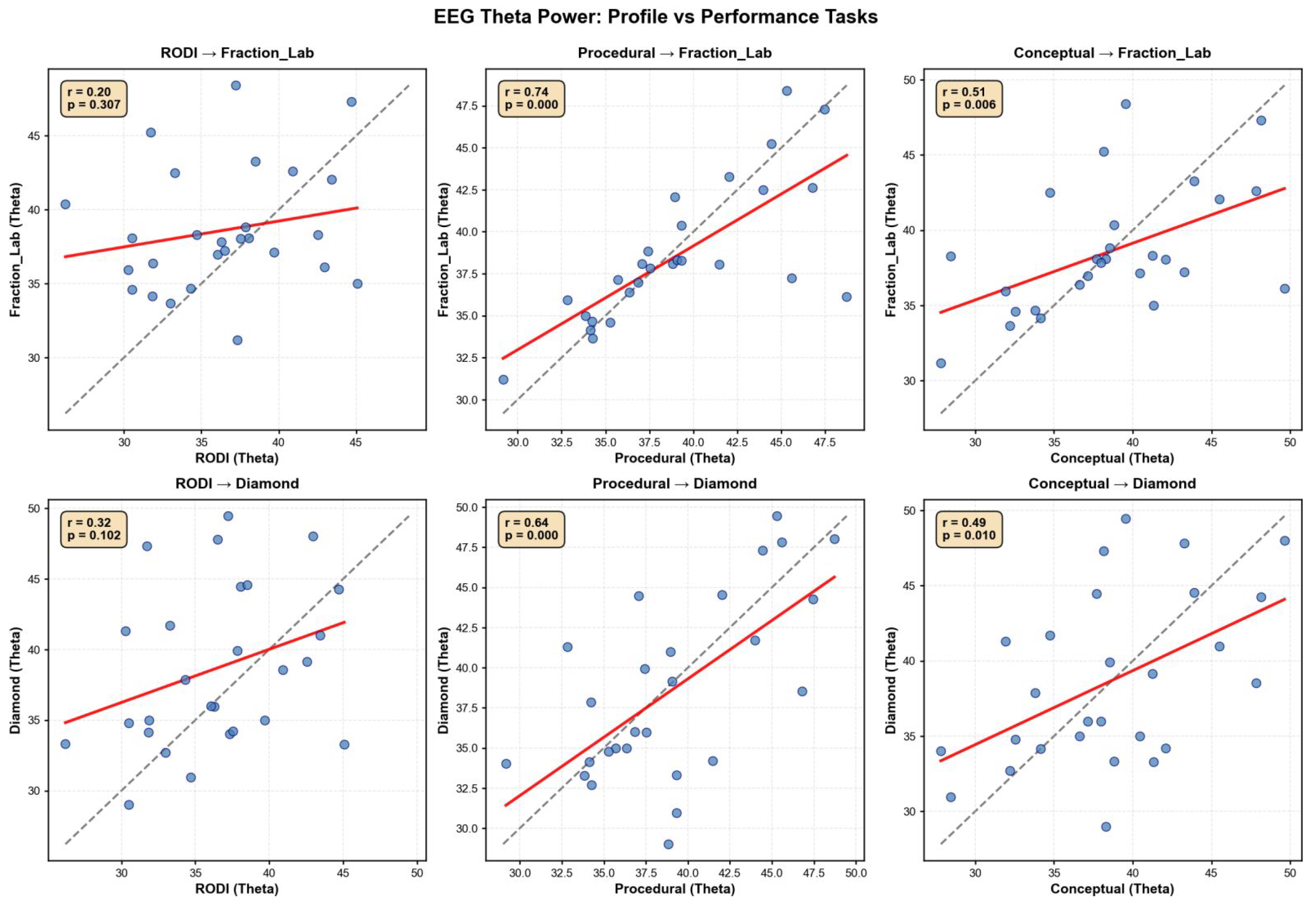
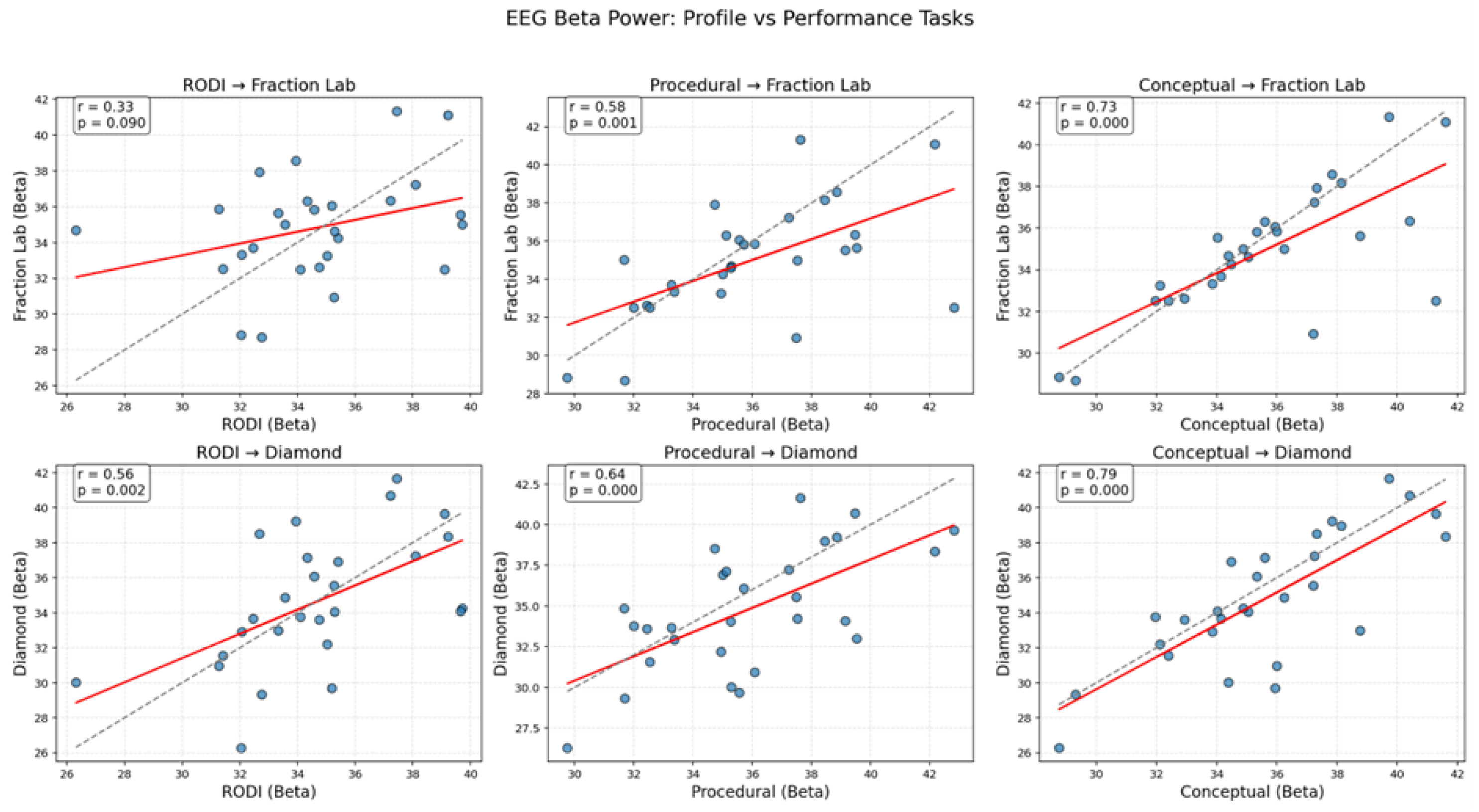

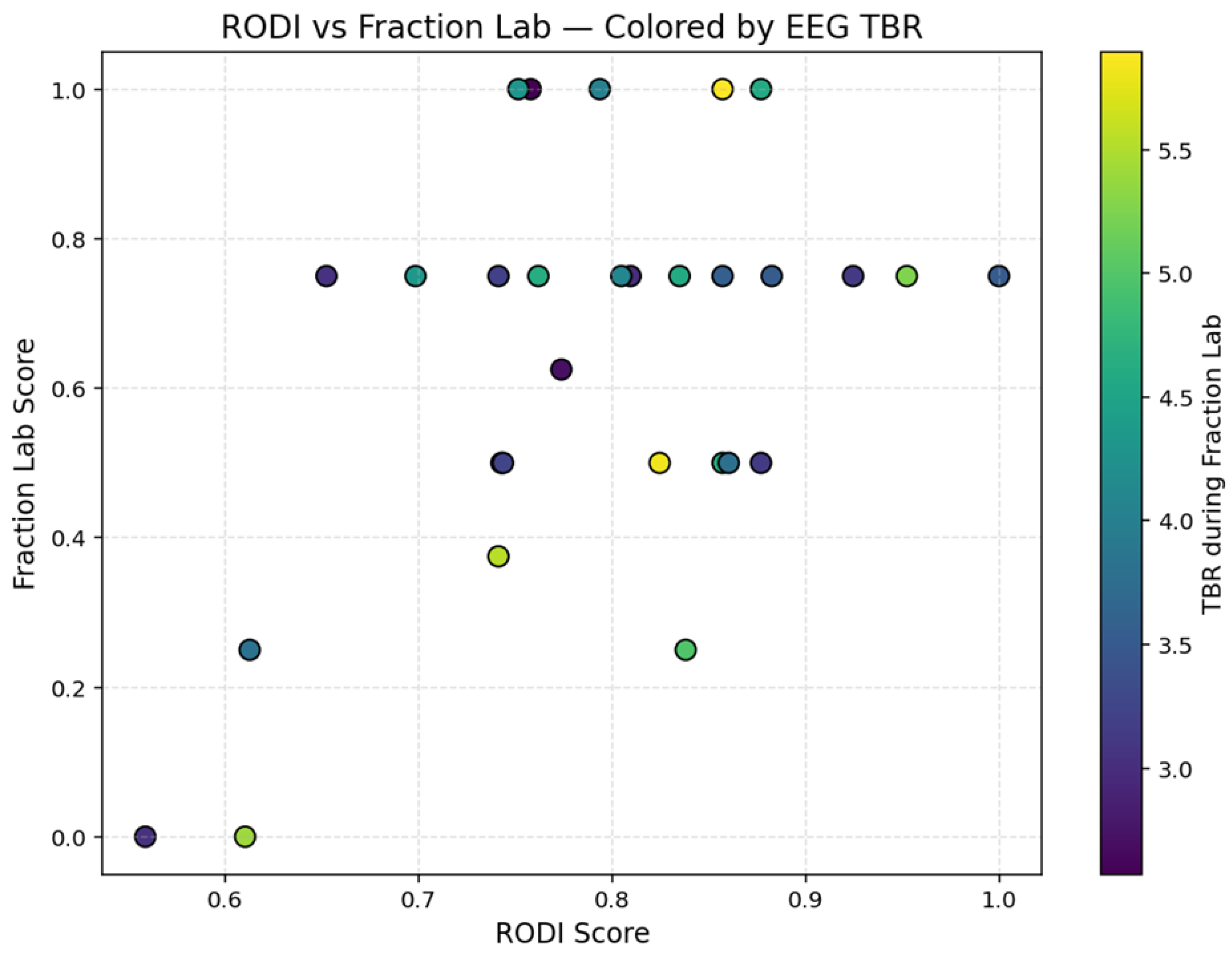

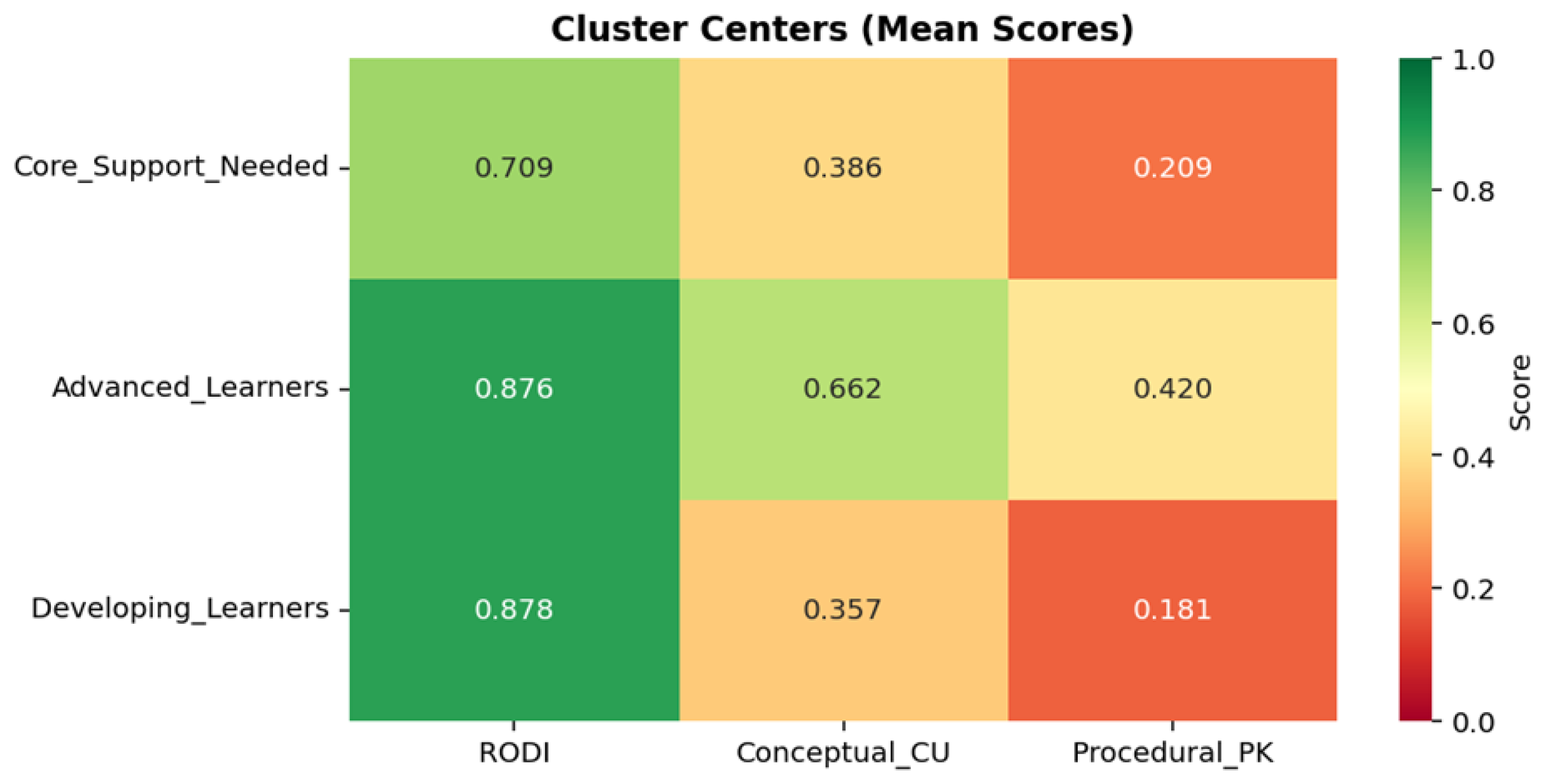

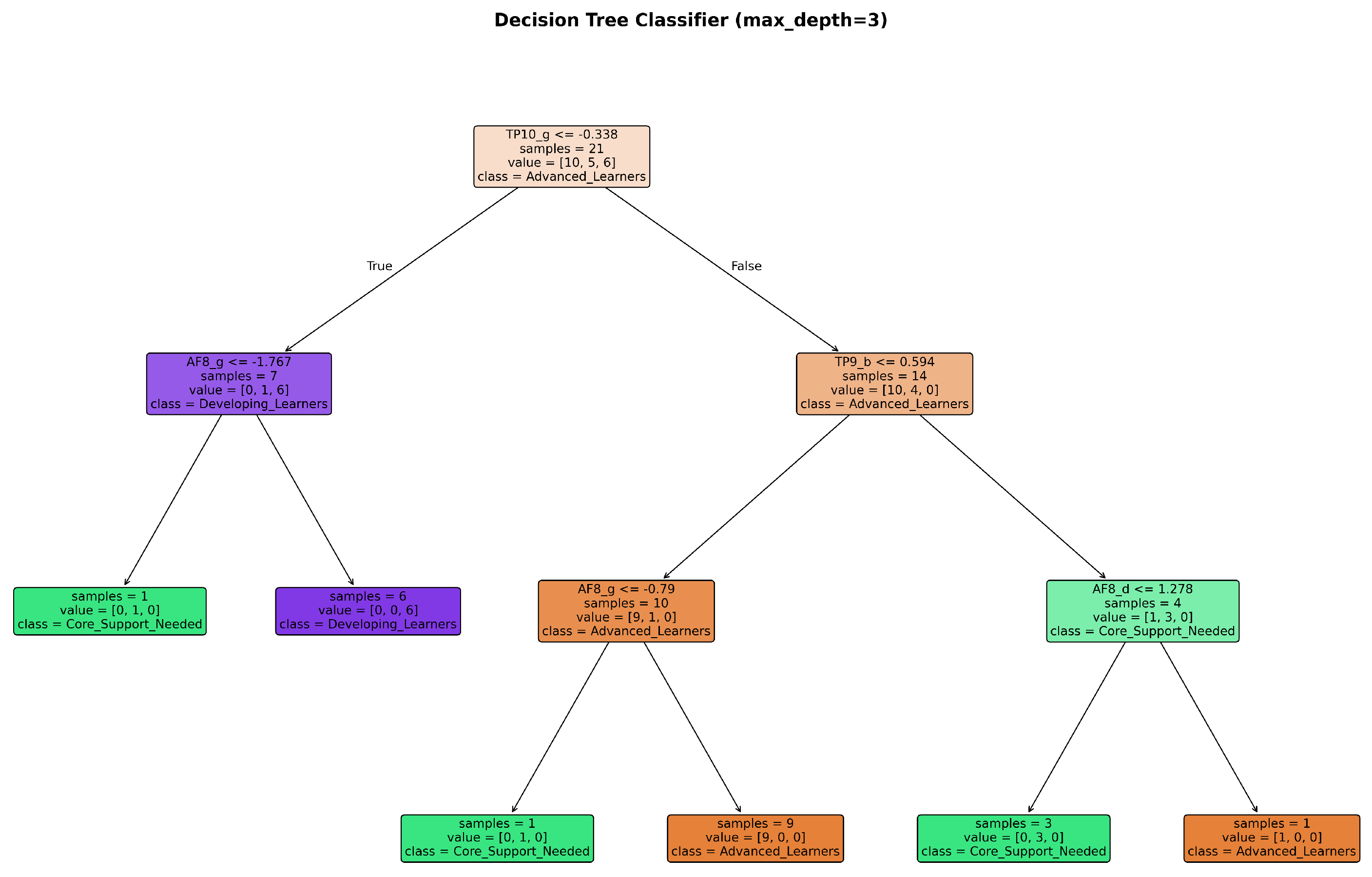

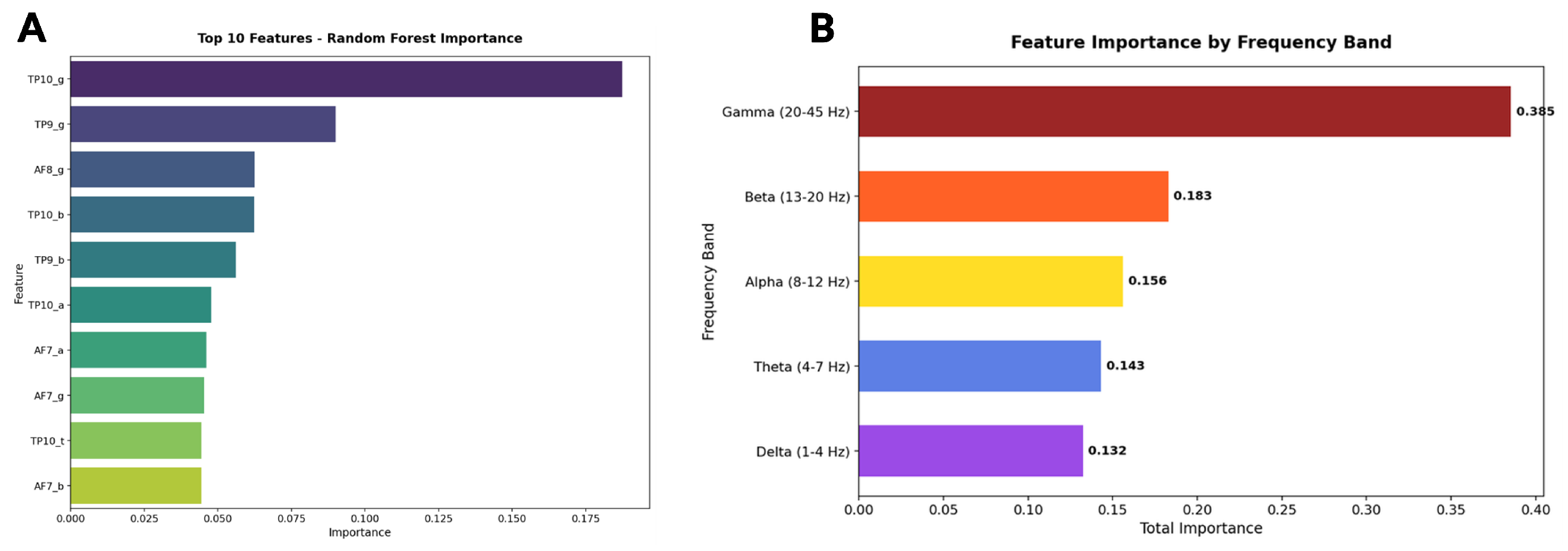
| Sensor | Frequency Band | F4,134 | p-Value | Conditions |
|---|---|---|---|---|
| AF7 | 3.17 | 0.016 | Rodi-CK, Rodi-Diamond | |
| AF7 | 2.69 | 0.034 | Rodi-Diamond | |
| AF7 | 2.69 | 0.034 | Rodi-CK, Rodi-Diamond |
Disclaimer/Publisher’s Note: The statements, opinions and data contained in all publications are solely those of the individual author(s) and contributor(s) and not of MDPI and/or the editor(s). MDPI and/or the editor(s) disclaim responsibility for any injury to people or property resulting from any ideas, methods, instructions or products referred to in the content. |
© 2025 by the authors. Licensee MDPI, Basel, Switzerland. This article is an open access article distributed under the terms and conditions of the Creative Commons Attribution (CC BY) license (https://creativecommons.org/licenses/by/4.0/).
Share and Cite
Lekati, E.; Dimitrakopoulos, G.N.; Lazaros, K.; Giannopoulou, P.; Vrahatis, A.G.; Krokidis, M.G.; Vlamos, P.; Doukakis, S. Wearable EEG Sensor Analysis for Cognitive Profiling in Educational Contexts. Sensors 2025, 25, 6446. https://doi.org/10.3390/s25206446
Lekati E, Dimitrakopoulos GN, Lazaros K, Giannopoulou P, Vrahatis AG, Krokidis MG, Vlamos P, Doukakis S. Wearable EEG Sensor Analysis for Cognitive Profiling in Educational Contexts. Sensors. 2025; 25(20):6446. https://doi.org/10.3390/s25206446
Chicago/Turabian StyleLekati, Eleni, Georgios N. Dimitrakopoulos, Konstantinos Lazaros, Panagiota Giannopoulou, Aristidis G. Vrahatis, Marios G. Krokidis, Panagiotis Vlamos, and Spyridon Doukakis. 2025. "Wearable EEG Sensor Analysis for Cognitive Profiling in Educational Contexts" Sensors 25, no. 20: 6446. https://doi.org/10.3390/s25206446
APA StyleLekati, E., Dimitrakopoulos, G. N., Lazaros, K., Giannopoulou, P., Vrahatis, A. G., Krokidis, M. G., Vlamos, P., & Doukakis, S. (2025). Wearable EEG Sensor Analysis for Cognitive Profiling in Educational Contexts. Sensors, 25(20), 6446. https://doi.org/10.3390/s25206446












